Previously on Drokk!: Things are all good in the 22nd century, as long as you’re a reader from today just visiting Mega-City One for the Thrill Power. After nuclear apocalypse and orangutans being elected to political office, I can only imagine what it’s like to live there…
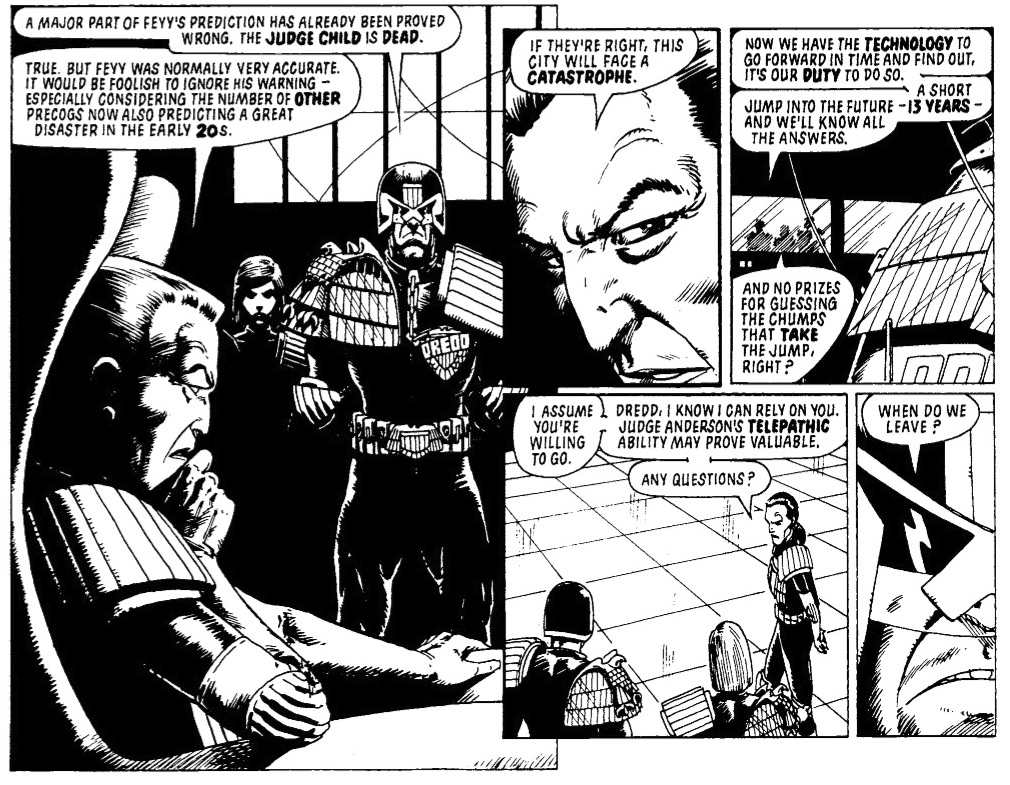
0:00:00-0:02:44: Welcome, dear friends, to a Drokk! unlike any other, at least insofar that Jeff and I were both poorly when we recorded it, but more importantly, neither of us particularly dug Judge Dredd: The Complete Case Files Vol. 8, the massive slab o’comics that we’re covering this time around. It’s all the Dredds from 2000 AD Prog’s 376 through 423, which is a lot of Judge Dredd, but it was also… a bit of a slog, as we quickly get into.
0:02:45-0:07:51: Is this, as I call it, the “flop sweat volume”? Has the previously untouchable writing team of John Wagner and Alan Grant lost its way, or merely taking a breather while relying all-too-much on a medley of the greatest hits from the strip’s past? If it’s the latter, there’s a problem, as we talk about: This isn’t a book that does the greatest hits any favors.
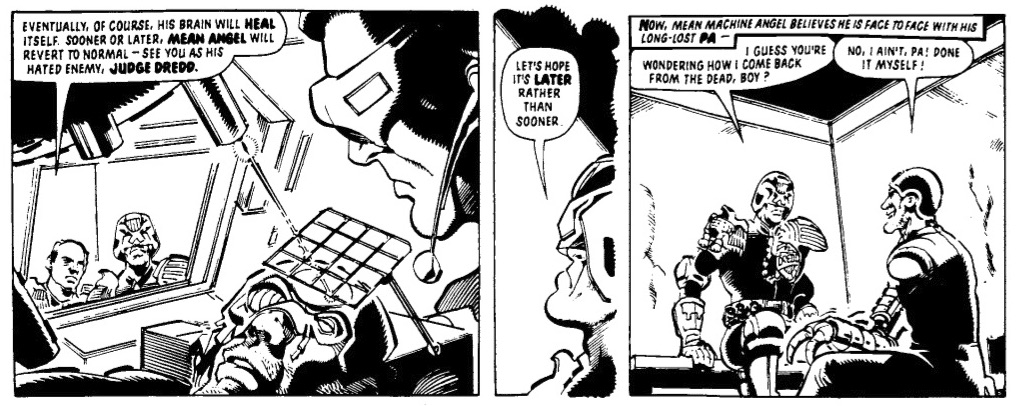
0:07:52-0:18:42: Almost accidentally, we fall into a discussion of the first extended storyline in the book, “Dredd Angel,” which has some good gags, but little else, raising our ire — mine especially — with the missed opportunities to make some kind of larger point about Dredd’s mission in amongst Liberace references and butt jokes. (No, a different kind of butt.) Jeff, at least, is enamored with the idea of Tulsa melting because of an atomic blast, so there’s that.
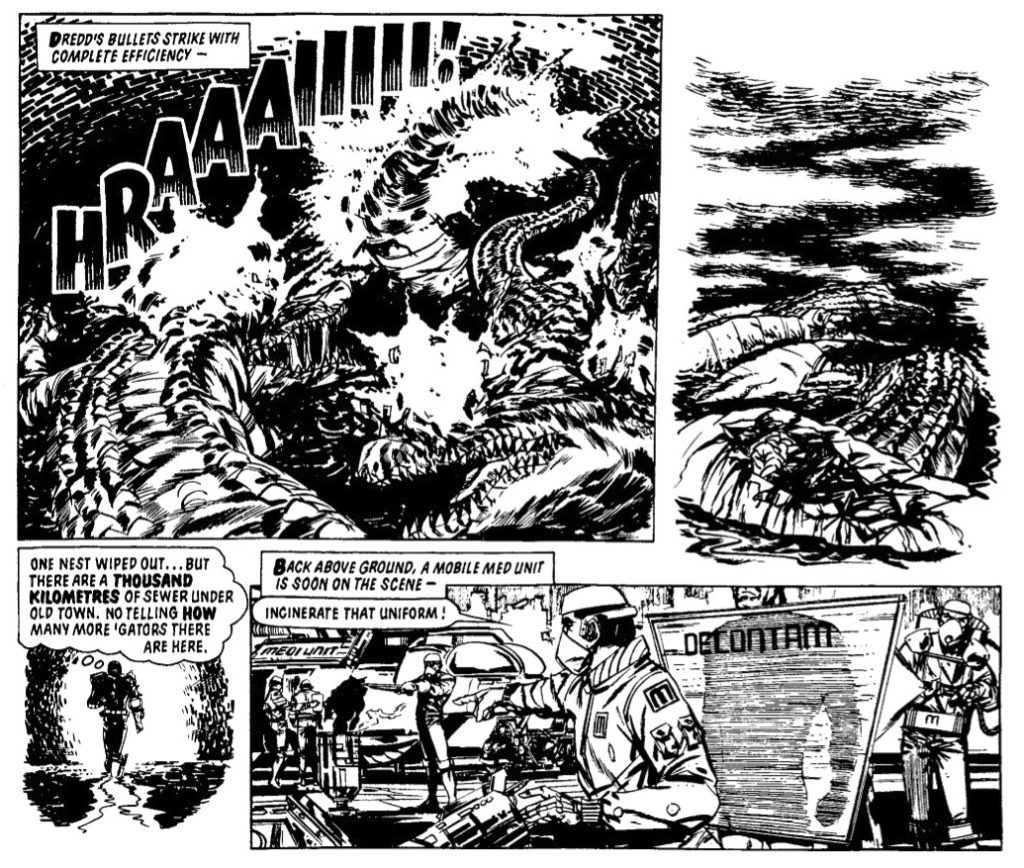
0:18:43-0:23:59: If “Dredd Angel” was disappointing, then “Gator” is genuinely wretched thanks to some very poor art choices and a story that feels like it was put together by Wagner and Grant on a series of off-days. In retrospect, this really was a bad omen for what was to come, but as if to make it worthwhile, Jeff teaches me some albino alligator history.
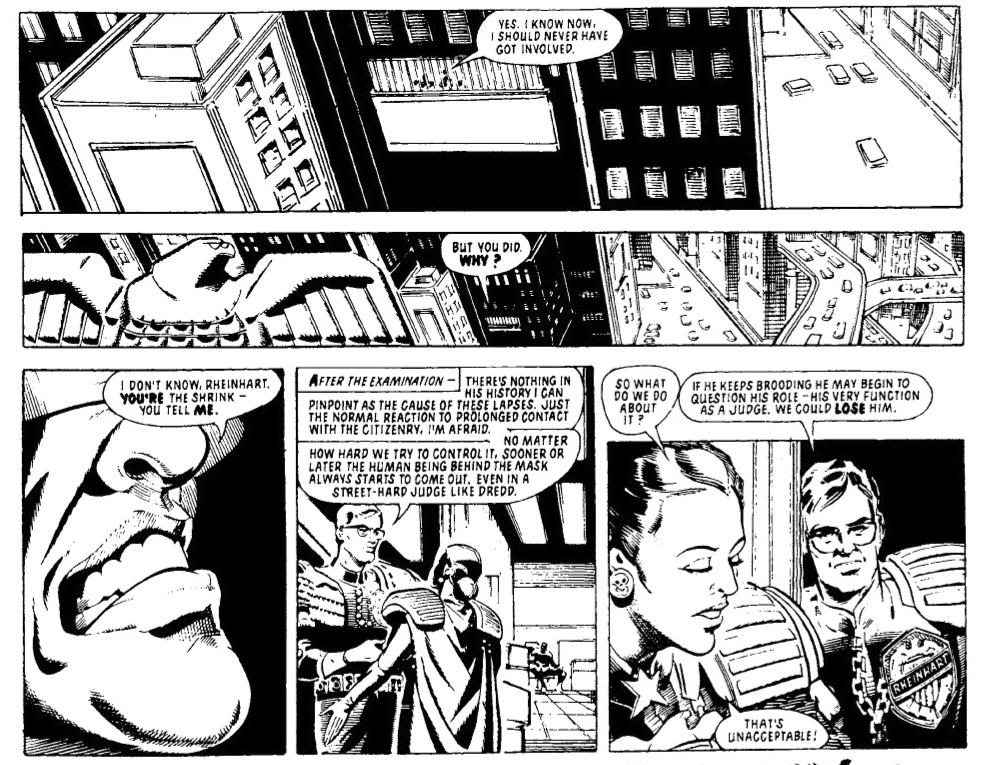
0:24:00-0:44:45: The “Judgment” trilogy — an unofficial way to describe three stories that delve into whether or not Dredd is growing a conscience, and if that’s a good or a bad thing in the world he’s living — is one of the two highlights of this volume, and we unpick how dark the three stories are, the ways in which they subvert audience expectations for this kind of story, and the running gag of Dredd not getting on with accountants. All this plus: Robot children are scary! The creepy institutional stance on emotions when it comes to being a Judge! And: A cliffhanger that stays hung for longer than you’d expect!
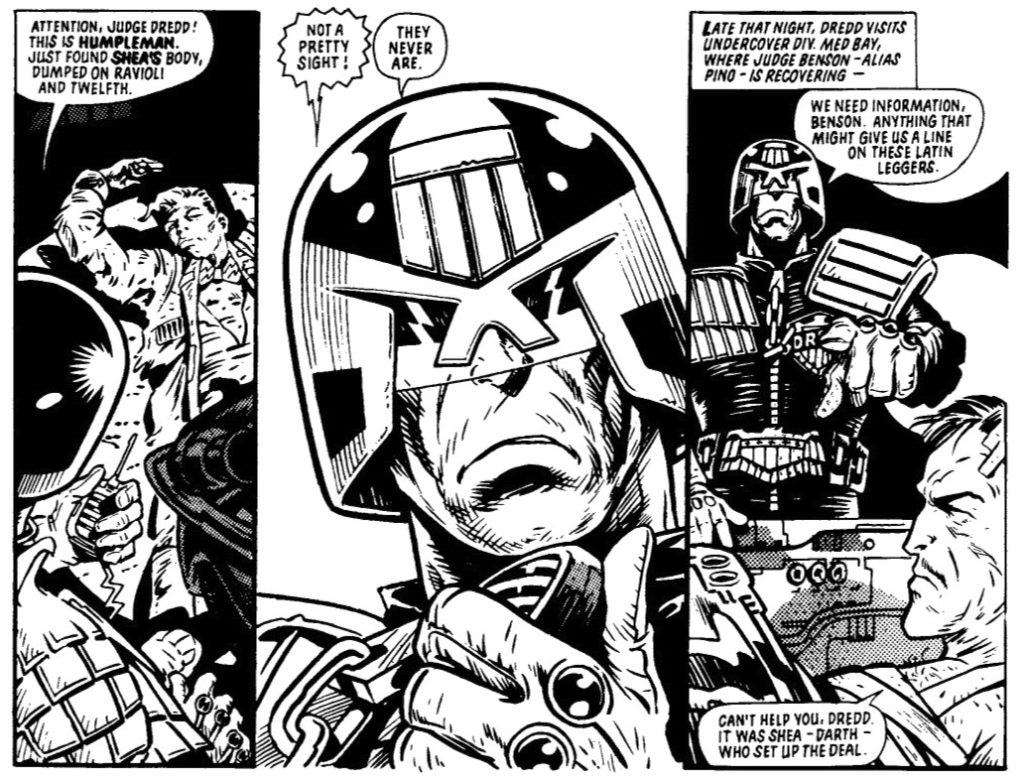
0:44:46-0:47:43: Before we get to “City of the Damned,” it’s time for a brief respite when “The Wally Squad,” which boasts some great art by Brett Ewins and, for one episode, “McCarthy” (Brendan? Jim? It’s unclear, but I suspect the former.) The story is light, but Jeff suspects that’s exactly what everyone needs at this point in the book. (We also touch on Jeff’s feelings on the trope of an undercover cop going bad, which is what this story is about.)
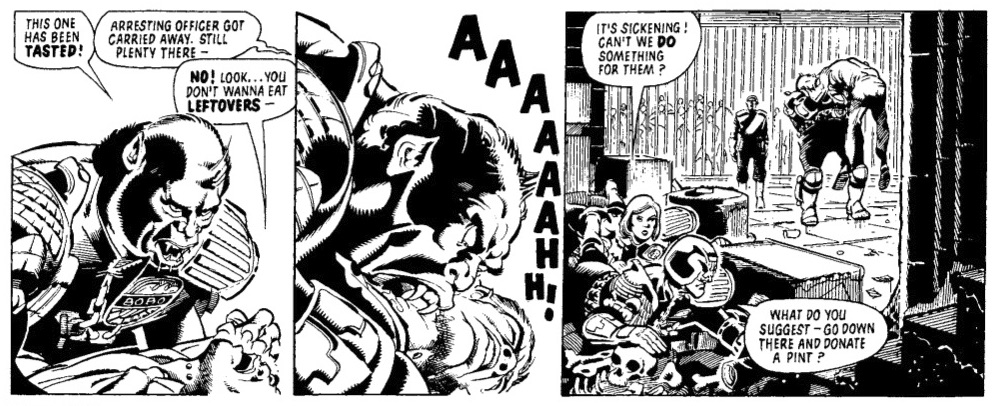
0:47:44-1:21:24: “City of the Damned” is the heart of this book in more ways than one — it’s the longest story in here, but it’s also a deeply flawed story that sums up the disappointment of the collection in one fell swoop, with Wagner and Grant seeming disinterested in their own work and featuring some lackluster artwork from Ron Smith. That doesn’t mean that Jeff and I don’t have a bunch to talk about, especially because it brings about a return of Jeff’s obsession with the Shadow Self, which prompts a discussion about whether or not the writers were fully aware, never mind engaged, in the subtext of what they were writing, as well as whether or not Dredd is capable of change — or, at least, whether Wagner and Grant think that he is. We also talk about my nostalgia steering me wrong (not for the first time), the wasted potential of this story, how quickly it goes off the rails, and two ways in which this storyline is echoed in Dredd strips to come. Not bad for something that I describe as “literally a Scooby-Doo chase for 14 episodes.”
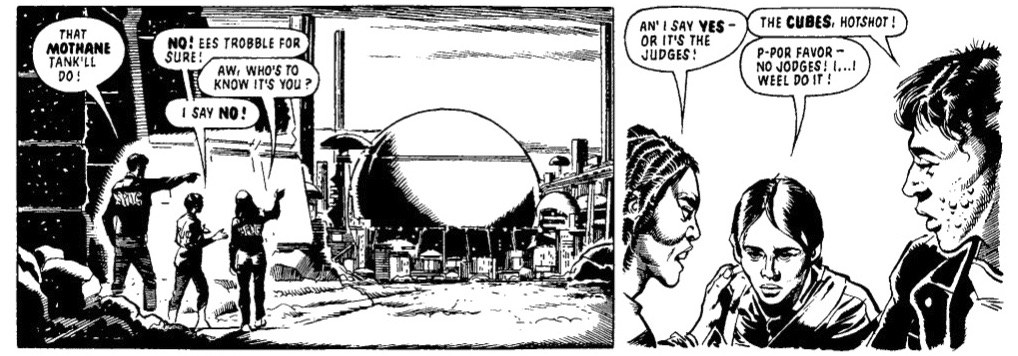
1:21:25-1:31:12: Again, if “Dredd Angel” was followed by something disappointing, “City of the Damned” suffers the same fate, with both “The Hunters Club” and especially ‘Monsteroso” utterly underwhelming us in terms of being overlong and unoriginal. (Really, a “robots gone wild” story? We haven’t seen those in, what, seven or eight volumes?) Oh, and then there’s the casual racism — and appalling denouement — of the firestarter storyline, as well. Jeff makes a reference to a mention in Thrill Power Overload about how burned out everyone at 2000 AD was feeling at this point, and, really? You can tell.
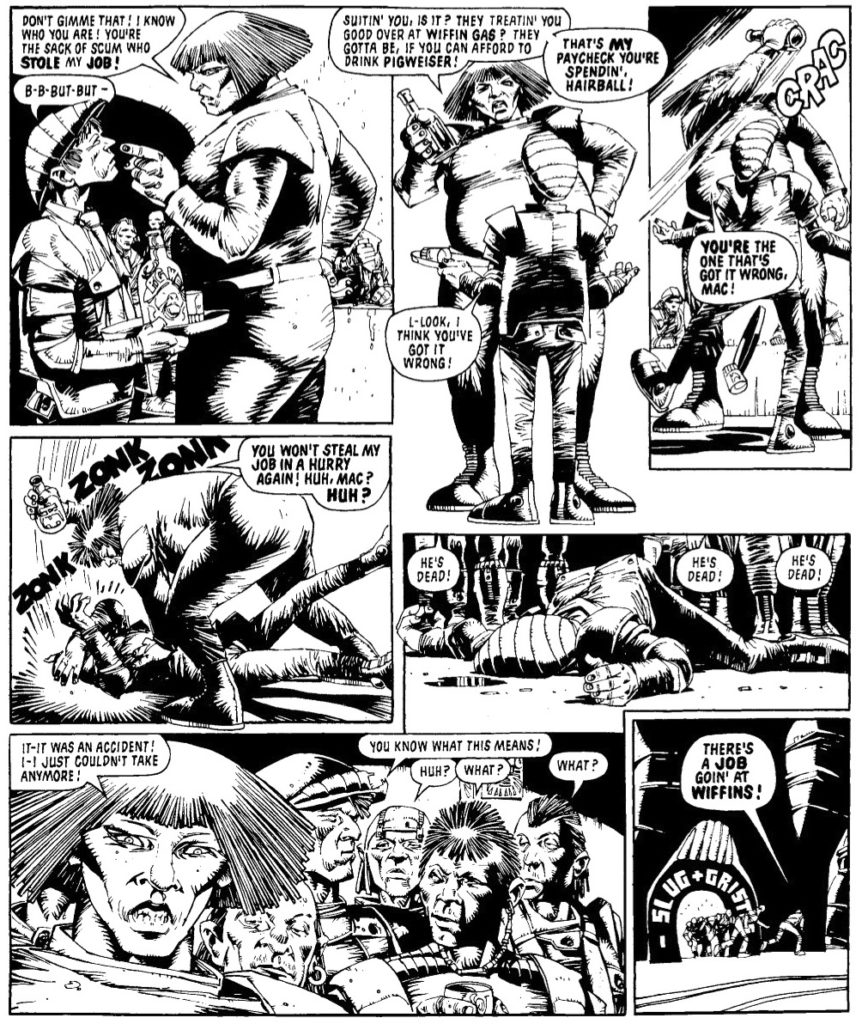
1:31:13-1:42:23: It’s not all bad news, though, as “Sunday Night Fever” brings Cam Kennedy on art and a story that has genuine weight to it, especially considering the era in which it was created. Out of nowhere, it’s as if Wagner and Grant have remembered that Dredd can be used to actually say something about the world. We also talk briefly about two other strips of note, both of which focus on the idea that Judges really shouldn’t have feelings — which is probably the running theme of this collection, all things considered. Also: the Judges really don’t care about the citizens of Mega-City One, but do like the idea of lasering people’s brains just a little bit too much.
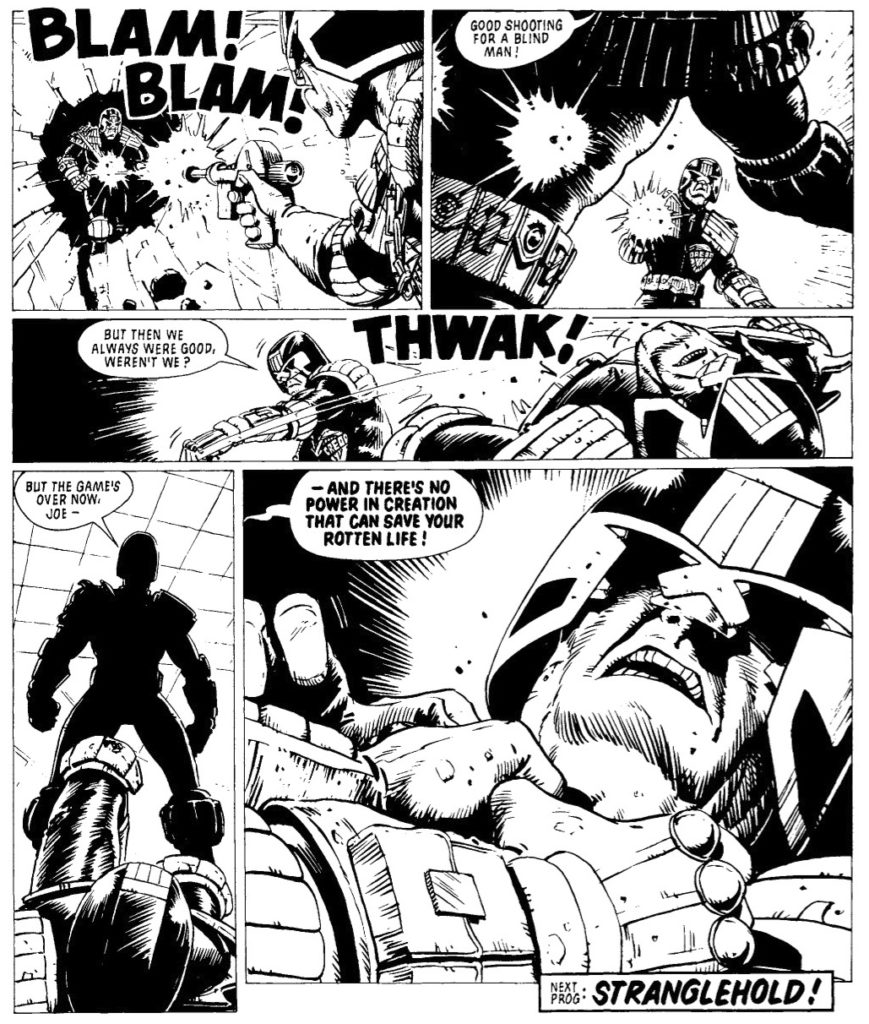
1:42:24-end: We wrap up by talking about what might have gone wrong with this volume to make it such a disappointment, from exhaustion on Wagner and Grant’s part to an over reliance on gimmicks, references and cheap jokes. (Introducing my unlikely reference to Darby and Joan!) The volume is enough of a disappointment that both Jeff and I point out that we probably wouldn’t recommend it to any newcomers, but at least Jeff and I agree on the highlights to be found inside. Before too long, we’re talking about our Tumblr, Twitter, Instagram and Patreon, and then looking forward to next month’s Case Files Vol. 9 read-through. (I completely forgot it has “The Midnight Surfer” storyline, despite the fact that this volume ends promising that next prog! I am a disappointment to everyone.) As always, thanks for reading and listening. Splundig Vur Thrigg, as the kids say.


A pleasure to listen to as always. I was thinking ‘Shadowself’ at least a minute before Jeff said it, so I think I must be ready for the test.
It’s interesting how divergent our tastes in art are, but I’ll get to that. First, I really enjoyed hearing about how the art was re-sized and remixed. The art looks as if there’s line drop-out in places, like at the first two pages of the Judgement trilogy. I was thinking it was perhaps just the copy I was reading, but maybe not. An odd thing I noticed (and don’t recall from the originals) is the poor lettering in the credits boxes. I can’t believe it’s Frame and don’t know why it’s like this, does anyone know?
I really became conscious reading this volume how great a Judge Dredd artist Steve Dillon was. I think he never really registered that way before because I don’t think he ever got a particularly great story to draw. Maybe there’s one to come, but I don’t recall it.
The McCarthy on the Ewins and McCarthy artwork is Brendan McCarthy. Admittedly, that is only based on looking at it and knowing what they each draw like. Also Jim McCarthy comes along later as an artist, while the first I noticed Brett and Brendan was their Sometimes Stories. Brendan’s style is also all over the first part of the Wally Squad, even though he isn’t credited. It’s a little like looking at some Simon and Kirby artwork and seeing the different hands aiming at a similar goal.
Ron Smith’s work is showing comparative wear and tear from being the most prolific Dredd artist at this point. However, do any of the other artists here regularly depict the size, scale and sheer sense of Mega City One as a populated space the way he does? If MC1 is a character, he was the artist who found a way to show it as a plausible place, as opposed to say McMahon’s (brilliant) impressionistic vision.
Jeff really enjoys Cliff Robinson’s first Dredd strip here to a degree I don’t. It’s fun to see this presumably young artist step to Brian Bolland with his technical pens and gusto. It’s ambitious and shows nerve to invite the comparison, but when invited the awkward anatomy, the lack of understanding of anatomy and the places where the shading fights the picture instead of revealing it all jump out at me.
It’s fun(for me) to note these differences in taste, a very literal case of looking at things differently. It’s useful to notice we’re disagreeing, but you aren’t wrong.
Oh and reading the Judgement Trilogy at the time raised my expectations in a way that subsequently left the strip feeling disappointing. I only occasionally pick up 2000AD now, Xmas and the occasionally jumping on progs. There was one of those last week. Hopefully without spoiling anything, it had a lot of the Dredd I like in it. Also, can someone tell me when Colin MacNeil shifted his style? This work is good, but it’s so different from before. Is there a period of transition? It’s rare for an artist who has a successful and attractive style to dismantle it and build another, but I find it so interesting to see.
The Hunter’s Club is underwhelming, as there’s not much to the story beyond the presentation of the concept. Wagner clearly is fascinated by the Hunter’s Club, though, as he returns to the concept with Button Men, and uses the pitch for the introduction to A History of Violence. So this is very much a first draft that he returns to multiple times over his career, both in Dredd where the Hunters’ Club pops up repeatedly, and in his other non-Dredd work. However, much like listening to a bands early demo reels, there isn’t much here beyond recognizing a theme that gets developed later.
As for the larger issues in this book, you both are right in how exhausted Wagner and Grant are at this point, but I also think there’s a deeper issue here. Wagner and Grant are two years past the Apocalypse War at this point, and have reached the point where the fallout from that story isn’t providing any more material. So the old idea well is dry, but they haven’t figured out where they want to take the strip next yet. Additionally, cancelling City of the Damned halfway into the story probably left them scrambling to fill the schedule with whatever they could throw at the wall. So you get Dredd questioning himself, and you get the job riot, and a lot of rehashing old ideas to meet a deadling, and it’s all still half formed and not satisfying.
As you both mentioned, the triptych of Dredd in therapy is their attempt to find a new way forward with Dredd and immediately backing off because they aren’t ready to commit to the full implications of the approach. It should be mentioned that, at this time, Thatcher had just won re-election and went from being just another PM to being THATCHER, and Thatcherism as a movement became the central facet of life in the UK instead of the one-off anomaly the left had hoped she would be. This was also the point where Wagner and Grant became more concerned that their readership were un-ironically embracing Dredd as a straight hero, and were receiving letters from readers saying how the UK really needed more Dredd type police in real life. Graeme has mentioned that the last two books especially can’t make up their mind how they feel about the fascistic elements of the strip, whether they are satirizing or endorsing them. Right about now is the point where Grant and Wagner realize they can’t have it both ways anymore, but haven’t figured out how to actually address the issue in story without fundamentally threatening the strip’s ability to continue. They find their way forward in the next book, but I’ll hold off until the next episode to talk about that.
So this book becomes just as transitional as Vol. 3 was, but here it’s from creative exhaustion on from Wagner and Grant combined with them not knowing where to go next, or how to do it. So there’s a lot of re-hashes and vamping for time, and the aborted mega epic as they cast about for something to fill the next hole in the schedule. It’s very much fifth season of a sitcom, where the jokes have worn thin but no one has figured out how to fix that. Next volume is them finding their second wind, but it leaves this book as a lost year.
That said, there is no better example of the “Dredd solves story problems by shooting them” approach than City of the Damned. You realize this story is just really boring and not working? Fine, Dredd will shoot a baby and call it a day.
Chiming in to agree with Jared agreeing with our hosts. Our hosts may want listeners to explain in the comments why they are wrong and the stories in this volume is brilliant, but sorry: our hosts are 100% correct.
As is Jared: Wagner & Grant have run out of tricks (for the moment). The recycling is very obvious – I mean, Dredd Angel and City of the Damned aren’t just doing the greatest hits, they’re doing the *same* greatest hit.
Basically, I think the “Tales of Mega-City One” approach that W&G were doing a lot in the previous year, where they treat Judge Dredd as a setting and not as a central character — that was the last thing that they had that they could could do with this strip. (again, for the moment). I think Jeff Lester is right: the problem is that Dredd himself is a character who is “supposed” not to change – rigid unbending discipline is the point of him. So at some point the stories have to be about someone else to do something new.
But this volume sees W&G back off from that “Tales of Mega-City One” approach and recenter the strip back on Dredd himself. Doing stories in which Dredd is a supporting character becomes another trick to recycle occasionally (“The Hunter’s Club,” “Juve’s Eyes”), but for the most part, this is back to being a series of stories that are emphatically about Judge Dredd and not about other people.
I thought Jeff Lester’s comment about the working conditions at 2000 AD incentivizing phoning it in was very much to the point.
(On that note, one thing to track from about this point is the British Invasion. Moore’s Swamp Thing starts appearing from February 1984, so this is about the time when other British writers would have started to become increasingly aware that they could make more money writing for American comics. Still early days there, but worth looking out for.)
Similarly, one has to wonder if part of why Dredd moves back to the center is about raw commerce. Last time, Matthew Murray commented on a cover that was, approximately, “2000 AD featuring JUDGE DREDD: this prog, JUDGE DREDD in an exciting new JUDGE DREDD story: “JUDGE DREDD and….”. Dredd was long since established at this point as unquestionably the single most lucrative piece of intellectual property in British comics. One has to wonder if there was an element of editorial direction to making sure that Judge Dredd was front and center in most Judge Dredd stories.
All this makers the Judgement trilogy simultaneously the best and most frustrating thing in this volume. Our hosts said some great things about how City of the Damned is so perfectly designed to be what the Judgement trilogy is the prologue to, and then doesn’t actually do those things that would make it the culmination of that overall story. This is the comics equivalent of seeing a great athlete take a run-up at some obstacle, and then refuse to jump over it, and instead walk back to the starting line.
As Jared also, this is after the 1983 general election. It’s hard to remember, but Labour were in government for most of the fifteen years between 1964 and 1979, and there was talk about Labour having become “the natural party of government.” By the mid-80’s, that phrase was firmly attached to the Conservative Party. Probably not intentional, but Dredd’s calcification into an unchanging mold mirrors what was apparently happening in politics.
Incidentally, Thatcherism is very relevant to why Sunday Night Fever seems to be the best case for Wagner & Grant being able to do the old tricks well and find good stuff in them. It’s not just a return to the old riposte of “Unemployment is not because people are idle; they want to work so badly that they are driven mad by its absence.” It’s also about mining. And from 1984-1985 headlines were largely dominated by the miners’ strike.
I’d even suggest that this background saves The Hunter’s Club a little. Yes, it’s a cliché. But with an increasing perception that Britain was increasingly divided between people, especially in the southeast, who were doing very well under Thatcherism and people, especially in old industrial areas, who were doing very badly, this was maybe not the worst time to haul out one of the classic “Social inequality = horror” tropes. It’s interesting to observe that this is a story in which Dredd *fails* and the Hunter’s Club are left at large to continue their depredations. The rich and well-connected get away with it, and always will, even in Mega-City One.
Mind you, on current form, that was probably just Wagner & Grant keeping the concept to be recycled later on.
Not that the Judgement trilogy is the only frustrating hint that Wagner & Grant are aware of the possibility of character development and shutting it down. One interesting development is a new quasi-religious aspect to Dredd’s thinking (Pat Mills might have been happy). The child clones are sacred flesh and the dead one must be cremated so that sacred flesh is not violated. This is very different from the kind of thinking about dead bodies that we’ve seen in Resyk. In fact, I think that’s part of the answer to our hosts’ “But can’t they just make more clones?” question — recovering the clones is presented as something of a holy mission for Dredd, and the clones matter for reasons that go beyond the purely practical.
(On the cloning, I recall as a child that I was a little annoyed that Ron Smith drew Fargo’s face, because it meant that we *have* seen Dredd’s face without his helmet, effectively. I still think that it was a mistake.)
Similarly, one can see hints of this religious Dredd in City of the Damned, when he talks about the Sector House having been “defiled.” And it’s obviously another thing that City of the Damned looks as if it was supposed to exploit and basically doesn’t. I mean, there’s the title. There’s the Mutant as an obvious Antichrist riff. The really obvious imagery. There’s even an attempt to seduce Dredd sexually, not a place this strip usually goes.
(Definitely something a little not great, incidentally, about vampire Hershey as the bad woman who has sex played off against the blonde angelic Anderson. But not great in a way that jibes with the rest of the Christianizing imagery in this story.)
All this looks suited to develop Dredd as a person whose faith in the system is *faith*, and whose faith was going to be tested. And then isn’t. I wonder if part of the problem was that W&G had backed themselves into a story where they could either have Dredd lose his faith or (more likely, given the imagery of City of the Damned) come through it with it strengthened. The first effectively risks ending Judge Dredd as we know it; the second would tip the delicate balance in which W&G don’t *quite* endorse Dredd’s authoritarianism towards full-throated endorsement.
I don’t have much to add. This was the first disappointing Dredd Case Files, and I think it took me a long time to slog through it compared to earlier ones. Still, I have managed to read through all the released Case Files (including the restricted ones and the Anderson ones) so it can’t have been so bad as to stop me wanting more!
I mostly just want to comment to say keep up the great podcast! It is always a treat to find out it has dropped! Keep them coming!
Thank you for the words of encouragement! Always appreciated, but especially after making it through a disappointment like this volume.
Nice to see you in a different context, omegoku!
Can someone tell me what prog number “Have the Judges Sunk so Law” was?